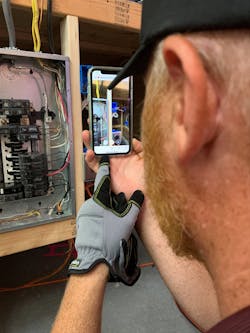When the COVID-19 pandemic lockdowns started in March, many states and municipalities deemed electrical contractors essential businesses, allowing them to continue operating. But to stay in business, they next had to overcome stranger danger: homeowner skittishness about letting strangers inside to provide estimates.
To get their foot in the door, some electrical contractors began offering virtual estimates. Applications such as FaceTime, Skype, and Zoom on smartphones, tablets, and PCs are technologies that most consumers already own and know how to use. Overland Park, Kan.-based Bickimer Electric uses the Stream platform, which co-owner Mike Bickimer likes because it provides more tools.
“You receive a text message at the time of the call,” he says. “You hit [the link in] that text message, and it connects you to our Stream. From there, I can use arrows and pointers to show you where to point the camera. It’s like a souped-up Zoom call.”
Bickimer is part of a group of electrical contractors that were offering virtual estimates a year or more before COVID-19. For whatever reason ― perhaps skepticism that something as complex as wiring couldn’t be accurately estimated without crawling into attics ― most homeowners went the traditional route.
“Nobody was interested in it,” Bickimer says. “They’d just rather have me come because they were wary of it ― until the pandemic hit. After COVID, that’s all we do now. Nobody wants you in their house. All they want is virtual. It was a complete 180 in terms of mindset.”
Before the pandemic, Calhoun, Ga.-based Phoenix Electrical did about 80% of estimates on site.
“Now it’s probably 50-50,” says owner Cynthia Little. “Every estimate that comes in, we try to do virtually first unless it’s a big thing, like a panel or a generator. [The pandemic] has turned homeowners around to being open to virtual estimates. I find they’re more willing to do that now, and I’m hoping that will continue when the virus goes away.”
For others, traditional estimates remain the majority but are declining.
“Before, most people preferred that we come out to their house,” says Bill Root, owner and founder of Woodbridge, Va.-based Root Electric. “Now, I’d say it’s 70% in person.”
Quick turnaround
Long before COVID-19, many electrical contractors offered ballpark estimates over the phone for straightforward projects, such as replacing a ceiling fan. With photos and videos providing more insights into the variables that affect labor costs and profit margins, it’s now possible to estimate a wider range of project types.
That can lead to more business. For example, a contractor that can provide an estimate the same day sometimes gets the job over competitors that take multiple days to respond.
“I just love the fast pace and being able to get back to them quickly because when somebody calls, we can’t always go and do the estimate the same day,” Little says.
Virtual estimates also save money by enabling owners and employees to be more productive.
“It’s saved me a lot of time,” Bickimer says. “I used to drive around all day. Now I just do my virtual estimates in two hours.”
“We’ve always been a big proponent of virtual estimates, even before COVID,” Little says. “It’s a way that we can make the most of our time and expenses. We’re a small company. The less time it takes to get an estimate out, the better.”
Nailing the estimate
Contractors that offer virtual estimates say the quick turnaround doesn’t have to come at the expense of accuracy.
“We can provide a virtual estimate approximately two to three weeks sooner than an on site and still retain the same accuracy,” says Gizzy O’Toole, operations manager for W. Danley Electrical Contracting, based in Monroe Township, N.J. “We are very thorough during our consults, and our team knows the path to take you on to design a great setup.”
Photos and videos also help narrow down the price range. That can close more sales because homeowners don’t get scared off by the high-end figure. But images don’t always provide a complete picture. Take the example of an outlet that’s clearly smashed to pieces. The homeowner says his child beat it with a hammer. Seems like a quick, straightforward repair.
“What we don’t see is that when he smashed that outlet, he pulled the connection loose on the daisy chain wires that go to the next one,” says Josh Gilmour, Mister Sparky multi-brand franchise business consultant. “There’s no way we can know that online.”
Visual insights also are limited by what customers are willing and able to provide. For example, electricians are used to crawling into hot, buggy attics and pulling up insulation batts to check wiring — homeowners, not so much. So, experience and a process for knowing when to say when are both key for avoiding expensive surprises.
“We can’t lift a section of drop ceiling to see if we might have to drill through support struts, [or if it] is wide open or perhaps involves a tricky turn that might call for flex pipe,” O’Toole says. “These situations of surprise costs are very rare as our team is very thorough on the initial consult, and we will follow-up with an on-site visit if we believe there’s a questionable section. That proactivity virtually eliminates disasters at installs.”
Others are skeptical, especially when it comes to complex projects, such as replacing a panel.
“There are probably 50 or 60 different things that you have to take into consideration,” Gilmour says. “What kind of wiring is inside? I can’t have a client open up their panel and stick their hands in it. That would be irresponsible.
“It also would be irresponsible to say: ‘Fifty percent of the time, the price is going to be three grand. Twenty-five percent of the time it’s $1,500. And another 25% of the time, it’s seven grand. So I’m going to sign you up for the seven grand, and we’ll work down from there.’ No client is going to buy that.”
Marketplace experience also helps with calculating an estimate that doesn’t come back to haunt because it’s too low or scares away the customer because it’s too high.
“One of our advantages is we know the architecture and the building styles for different builders in our area, and the different eras,” Root says. “We know what to expect in that house. We have a lot of intel in these spaces, so I can get a lot more out of my virtual estimates than my competitors can.”
Marketplace experience also can improve accuracy, to the point that it enables virtual estimates for a wider range of project types.
“We can generally give an accurate estimate for everyday kinds of installations: ceiling fans, recessed lights, ceiling fixtures,” Root says. “We can even get into panel replacements and service upgrades as long as we can do a video or get some pictures from the customer.”
Flat-rate pricing is another way to build in flexibility.
“When it comes to basic services like a ceiling fan replacement, installing a light fixture or replacing an outlet receptacle, we offer a basic cost,” Little says. “On our booking platform, we spell out that a ceiling fan replacement is $149.”
Virtual service calls next?
For decades, many contractors have walked customers through simple fixes over the phone.
“Rather than coming out and charging for a service call, [we tell them how to] push a button on a GFI or reset a circuit breaker,” Root says. “That’s something we’ve always done. It’s just good customer service.”
The technologies that power virtual estimates could enable a wider range of remote support services ― including billable ones.
“I always wanted to start a company where I troubleshoot problems virtually,” Bickimer says. “I’ve always been able to walk them through it on the phone, but the technology was never there.”
After finding the Stream platform, and then using it for virtual estimates, Bickimer launched The Virtual Electrician (TVE).
“It acts the same way as our virtual estimate, but I tell you how to fix your problems,” he says.
Bickimer shot 150 short videos that show how to use tools such as circuit breaker finders and perform tasks, including continuity testing. He’s posting a new one each week on YouTube to build awareness.
“Each video is a call to action to go to TVE,” he says. “We’re going to show you how to use a multimeter and do things to do it yourself. But if you can’t do it yourself, come to TVE, and we’ll help you through it.”
The Internet of Things (IoT) could enable a wider range of virtual services in years to come. For example, some types of industrial equipment, such as motor control centers (MCCs) and switchgear, now have internal thermal sensors that can send readings wirelessly. That data can go to the smartphone of an electrician standing several yards away for safety reasons, or use a Wi-Fi access point as the on-ramp to the internet.
The residential market could adopt a similar model ― and probably will as smart homes become the norm. For example, IoT sensors embedded in outlets, switches, and circuit breakers could provide enough information for electrical contractors to troubleshoot over the internet. That could lead to a virtual estimate and then a service call.
“We’ve run our diagnostic and identified that it’s in outlets No. 2, No. 4, and No. 7, and it’s going to cost X to do,” is how Gilmour envisions one future scenario.
Or, depending on the problem, the contractor could conduct a virtual service call that walks the customer through repairs for a fee.
“There are some products being introduced that do analysis on HVAC machines,” Gilmour says. “But as far as the electrical side of the business, we don’t have anything like that yet.
“Is technology going to get there where we can diagnose and pinpoint exactly where a problem is? Absolutely. I guarantee that there are a thousand people working on that right now.”
Kridel is an independent analyst and freelance writer with experience in covering technology, telecommunications, and more. He can be reached at [email protected].
SIDEBAR: Inspector Gadget
Virtual estimates help electrical contractors operate more efficiently by reducing the amount of time driving from one prospective customer to the next. Additional savings include less fuel and vehicle wear and tear. Compressing the estimate process means more employees now have more time to spend on billable work ― a major plus, given the chronic skills shortage.
For similar reasons, states and municipalities are increasingly offering virtual inspections. By reducing the amount of time driving from job site to job site, each inspector now can handle more inspections per day.
“Just about all of the large municipalities in our area are doing virtual inspections,” says Bill Root, owner and founder of Woodbridge, Va.-based Root Electric. “The only ones that are not are small towns or out in the country.
“The inspectors love them. One guy was smoking a cigar while he was doing it. He couldn’t do that at somebody’s house.”
As with virtual estimates, there are limits. For example, the Washington State Department of Labor & Industries will do them only if the inspection takes less than 15 minutes and won’t result in a final or service approval. Those restrictions help address some inherent challenges with the virtual model.
“The inspector only sees what the camera sees,” Root says. “They can’t stick their hands in the panel to make sure wires are tight. I think if this is going to last long term, they’re going to have to certify electricians to be able to do this. If you get someone who’s dishonest, you could really put one over on the inspector.”
About the Author
Tim Kridel
Freelance Writer
Kridel is an independent analyst and freelance writer with experience in covering technology, telecommunications, and more. He can be reached at [email protected].



